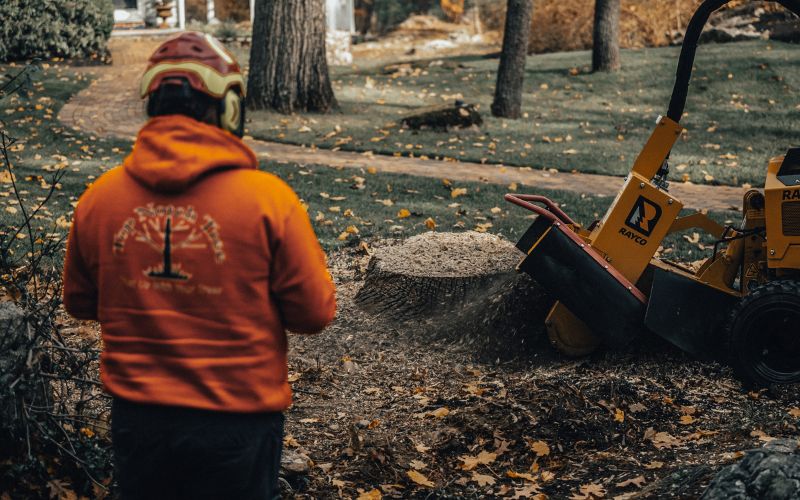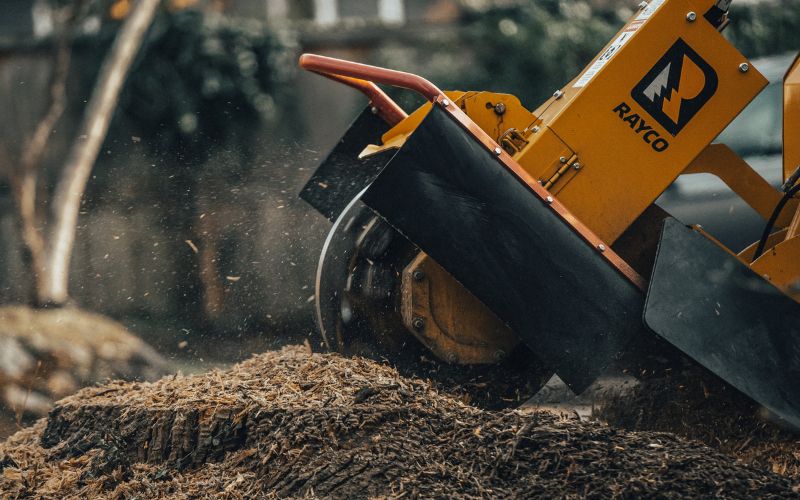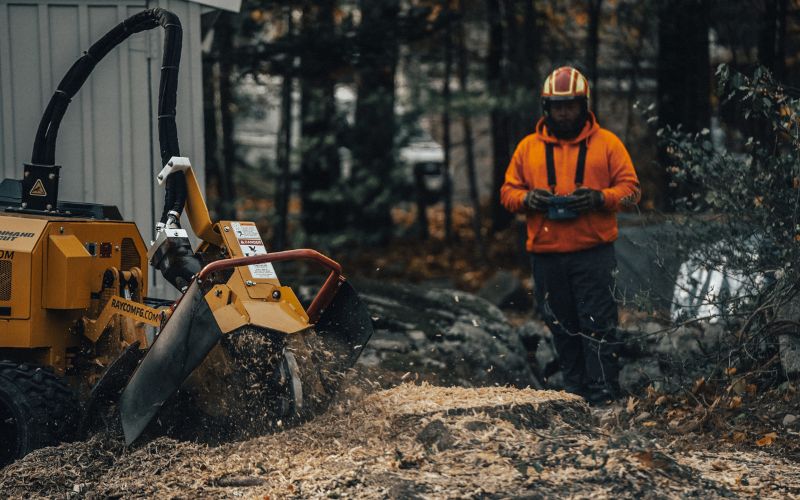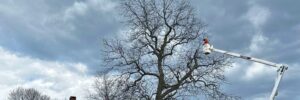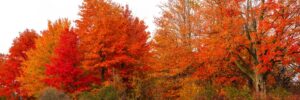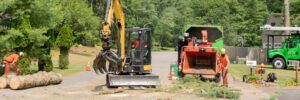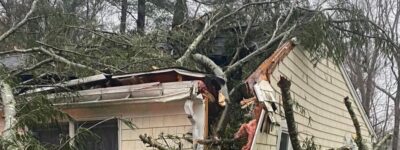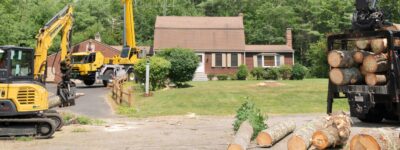Stump grinding challenges are just one of the trials of maintaining the beauty and safety of home landscapes in the picturesque towns on the Massachusetts South Shore. From Duxbury to Hingham, homeowners face several difficulties when attempting to remove tree stumps from trees that have been cut down.
What makes stump grinding on the South Shore so difficult? It all has to do with the types of trees in our area, the soil conditions, and the way our roads and towns are laid out. In this article, we explain what that means, how it affects your ability to remove a tree stump, and how to overcome these challenges.
Key Points About Stump Grinding on the South Shore
- Hardwoods like oak and maple found on the South Shore, as well as larger and older stumps, present specific challenges due to their dense wood, making stump grinding a tough task that requires more powerful equipment, more time, and greater expertise.
- Soil with surface-level or underground stones, as well as wet soils, make stump grinding more dangerous and time-consuming.
- Limited access, such as narrow lanes and closely spaced houses, requires the use of specialized equipment that can fit through tight spaces.
- DIY stump grinding can be dangerous and inefficient. Professional services ensure safe, effective, and complete removal, avoiding potential risks and property damage.
What is Stump Grinding and Why is it Necessary?
Stump grinding is the process of using a stump grinder, a powerful tool with a rotating cutting disc, to chip away the wood of tree stumps into small, fine pieces. This method is preferred for its efficiency and minimal impact on the surrounding area. It’s essential for several reasons:
- Aesthetics: Stumps can be an eyesore, disrupting the harmony of your landscape.
- Safety: Stumps pose tripping hazards and can make lawn maintenance difficult.
- Pest Control: Old stumps can attract termites, ants, and other wood-boring pests.
- Space and Growth: Removing stumps allows for new landscaping opportunities and prevents the stump from sprouting new growth.
Stump Grinding Challenges: Why It’s Tough to Grind Stumps on the MA South Shore
While it seems simple enough, stump grinding is actually a challenging and sometimes dangerous process. In our region, there are several things that make stump grinding particularly difficult, including:
- the tree species commonly found on the South Shore,
- soil conditions, and
- issues with access.
These factors combined make many stumps more difficult to grind. Understanding these characteristics will help you effectively manage stump grinding projects, ensuring the right techniques and equipment are employed for different types of trees.
How Tree Species Affects Stump Grinding Success
The hardness of the stump, as well as its size, are two of the main factors that contribute to the difficulty of grinding a stump. The hardness of a tree stump is determined by its species.
Grinding Hardwood Stumps on the South Shore, MA
The most difficult tree stumps to grind are typically those from hardwood trees such as oak, maple, and hickory. These trees have tight growth rings, resulting in denser and harder wood. This density makes them challenging to grind, requiring more effort and time compared to grinding softer wood stumps. Stumps from softer wood species, such as pine or cedar, or those that have been dead for a longer period are generally easier to grind.
Hardwood trees, known for their dense and sturdy wood, are common on the South Shore. Hardwoods are deciduous trees like oak, maple, and cherry, which lose their leaves annually. In our region, you’ll commonly find:
- Oak Trees: Known for their strength but can be challenging to grind due to their dense wood.
- Maple Trees: Also hard and dense, maple trees require more time and effort to grind.
- Birch and Cherry Trees: While slightly easier to grind than oak or maple, they still require professional attention due to their tough nature.
Removing Older and Larger Tree Stumps
Larger and older stumps present more difficulty in grinding due to their extensive root systems and increased wood mass. The size directly affects the amount of time and effort required to completely grind down the stump.
Additionally, older trees have more mature wood, known as heartwood, which is denser and contributes to the stump’s overall hardness.
Soil Conditions That Impact Stump Grinding
South Shore’s Stony Soils Stop Spinning Saw Blades on Stump Grinders
The coastal areas of the South Shore have a variety of soils, including sandy soils, loamy soils, and soils with a mix of clay and silt. These soils are influenced by the proximity to the coast and the specific environmental conditions found there.
But, as South Shore residents are well aware, we also have a lot of stones in the soil found in many towns throughout the region!
The South Shore’s landscape includes large areas of Paxton soil (the Massachusetts state soil) which is generally a coarse, loamy soil. However, it also tends to have many stones or rocks on the surface and the upper soil profile, which poses a significant challenge for stump grinding operations. Rocks can cause damage to the grinding equipment, leading to potential delays and increased costs for repairs or replacements.
If you have rocky soil around the tree stump, stump grinding will require careful planning and possibly the use of specialized machinery designed to handle rocky terrains.
Wet Soil Bogs Down Stump Grinders
Due to its coastal location, the South Shore is susceptible to higher moisture levels in the soil. Wet conditions can affect stump grinding efficiency in several ways:
- Soil Compaction: Wet soil is more likely to compact around the stump, making it more difficult to grind effectively.
- Equipment Handling: Machinery may have difficulty maneuvering in muddy or slippery conditions, affecting the precision of the grinding process.
- Debris Management: The mixture of wet soil and wood chips can create a challenging cleanup process, potentially increasing the time required to complete the job.
These soil conditions on the South Shore require a strategic approach to stump grinding, involving careful assessment of the site, appropriate equipment selection, and potentially adjusted techniques to ensure efficient and effective stump removal.
Property Access Limits
Limited property access can pose challenges for stump grinding in towns on the South Shore.
Narrow Roads & Backyard Entries Hinder Access
The unique layout of towns such as Cohasset, Duxbury, and Scituate feature narrow, winding roads and closely built properties. This characteristic can significantly complicate the transport of heavy stump grinding equipment to and from job sites and severely limit access to backyards and areas between buildings.
Specialized, smaller machinery may be needed to navigate these constraints effectively, such as the narrower (yet powerful!) stump grinding machines Top Notch Tree uses to easily pass through gates, alleys, and spaces as narrow as only 36 inches.
Landscaping Concerns Require Precision Grinding
The South Shore is known for its picturesque landscapes and meticulously maintained properties. In towns like Norwell and Marshfield, homeowners place a high value on preserving the aesthetic and health of their landscapes. Stump grinding operations must be planned and executed with precision to avoid unnecessary damage to lawns, gardens, and other landscape features. Techniques such as laying down protective planking for machinery to travel over can help minimize disruption.
Any stump grinding work done in South Shore towns must take into consideration these access and landscaping concerns, prioritizing the preservation of property integrity and appearance while efficiently getting rid of unsightly tree stumps.
Why Professional Stump Grinding?
Stump grinding should ideally be handled by tree service professionals, especially on the South Shore where rocky soil, extremely hard tree stumps, and limited access make the work particularly challenging. If you’re planning to remove a stump, consider these reasons to hire a stump grinding professional like Top Notch Tree.
- Expertise and Efficiency: Professionals like Top Notch Tree have the experience and equipment to do the job safely and effectively, removing the entire stump to prevent regrowth and pest infestation.
- Safety: Stump grinders are powerful and potentially dangerous tools. When handled incorrectly or without proper training, they pose a risk of personal injury from flying debris or improper handling of the machinery. Professional handling by highly trained crews ensures a safe operation.
- Damage Prevention: DIY stump grinding has a heightened risk of as property damage from accidental strikes to structures, unseen obstacles, or utilities. Professionals will ensure that the surrounding landscape and underground utilities are not damaged during the process.
Ready to Remove That Tree Stump? Call Top Notch Tree!
Stump grinding is a critical aspect of tree management that must be carefully planned out and executed with precision, especially when dealing with the tough hardwoods, rocky soils, and narrow spaces found on the South Shore of Massachusetts. Top Notch Tree is your local expert for safe and efficient stump grinding from Norwell to Scituate. Don’t let tree stumps be an unsightly, hazardous, or pest-attracting problem in your landscape. Call us today at 781-871-8008 for a consultation and let us take care of your stump grinding needs with the professionalism and safety you deserve.

